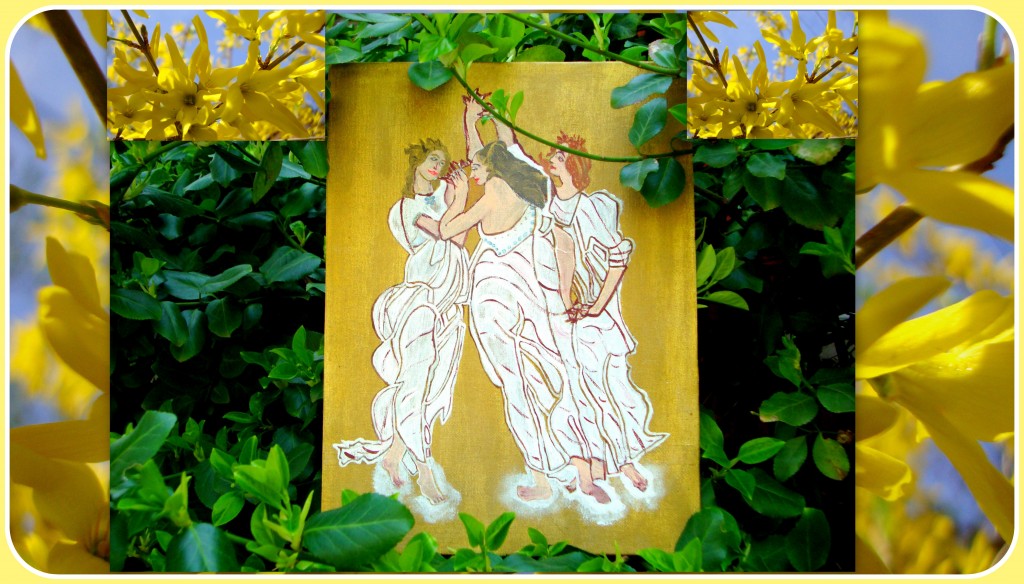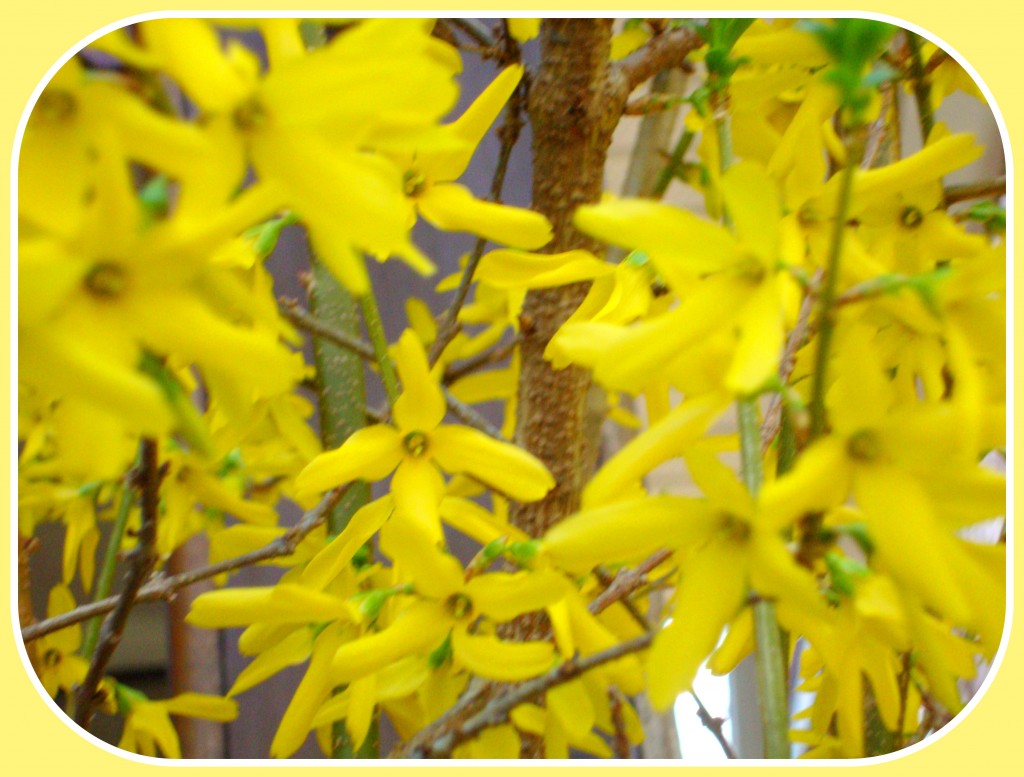
“Each of the arts whose office is to refine, purify, adorn, embellish and grace life is under the patronage of a muse, no god being found worthy to preside over them.” (Eliza Farnham)

The lovely bright, yellow forsythias, were in full bloom in our garden a few weeks ago. I don’t know how the idea came to me, but it did, to take my painting of “The Three Graces” and put it in the forsythia bushes and take some pictures. I also decided to try it in some greenery and you can also see the effect of this idea. I did this acrylic painting about ten years ago since dance and dancers have always had a special appeal for me. I was captivated by the beauty, elegance, and the poses of these ladies in their white, flowing dresses, in this work of art. I liked how their hands were intertwined and since the visual appeal was so great, my “muse” got to work.

Sandro Botticelli did the Primavera (Allegory of Spring) in 1482 and “The Three Graces” represent a detail from this painting. This picture celebrates the arrival of spring and is filled with mythological symbolism. I read that Botticelli put over 500 plant species and about 190 different flowers in this painting. In the painting, Venus, the goddess of love, is in the middle and the “Three Graces” stand to the left. It is believed that this painting was commissioned by a member of the Medeci family for the wedding of a family member. It hangs in the Uffizi Gallery in Florence to this day. I hope to get there one day to see this painting for myself.
Although, I like the “Three Graces” very much as a work of art and was inspired to do my own painting and photography, I never knew or bothered to find out the history behind the painting. However, after deciding to do this blog, based on the forsythias being in bloom, springtime, and my own curiosity, I found out the names of the three ladies in the painting: Euphrosyne, Thalia, and Aglaia. I was able to also find some other interesting information that sparked my attention and I have added it below to share with you.

Mythological Explanations of Creativity
1. The Muses: CALLIOPE, CLIO, EUTERPE, MELPOMENE, TERPSICHORE, ERATO, POLYHYMNIA, URANIA, THALIA
But the Greeks also had an unusual concept about the process of art and especially about the inspiration process in art. The Muses were nine goddesses, daughters of the god Zeus, king of the gods, and of Mnemosyne, the goddess of memory (if my memory serves me correctly). The Muses were believed to inspire all artists, especially poets, philosophers, and musicians. (The Greeks also saw the arts and sciences as being related, from which we still use the division of university colleges as “Arts & Sciences.”) They were said to come at special times of reverence or in dream states and whisper in the ear of the artist – the divine inspiration. Today’s artists and musicians often stilll use the phrase, “A visit from the muse,” in reference to this need for inspiration. We get our words “amusing, and musician” from this concept.
2. The Three Graces: EUPHROSYNE (Mirth) JOY; THALIA (Good Cheer) CHARM; AGLAIA (Splendor) BEAUTY
But it didn’t stop there. The Greeks also believed in The Three Graces, who were the three goddesses of joy, charm, and beauty. They were the daughters of the god Zeus and the nymph Eurynome. The Graces presided over banquets, dances, and all other pleasurable social events, and brought joy and goodwill to both gods and mortals. Like the Muses, they were believed to endow artists and poets with the ability to create beautiful works of art. The Graces were rarely treated as individuals, but always together as a kind of triple embodiment of grace and beauty. In art they are usually represented as lithe young maidens, dancing in a circle. This is a metaphor for a trinity of heavenly power, it’s manifestation of earthly beauty, and the divinity needed to transform one into the other.
Hope you enjoyed all the forsythia photos and the Mythological Explanations of Creativity. May your muse be with you wherever you go!
